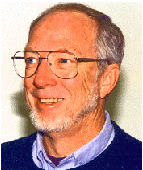
Research Interests
Coyne is the principal investigator of the NSF-sponsored Milagro subgroup of SCIPP. His group has taken major responsibilities in the construction and operation of the telescope described above, including a major part of the electronics and much of the experimental infrastructure. His own interests in the astrophysics centers on the detection and identification of possible short bursts of TeV gamma rays. One possible source of such short bursts is the Hawking radiation expected from the explosive evaporation of small black holes, presumed but never proven to have been produced in the Big Bang. Such searches are a long shot, but the physics and search techniques are fascinating. In contrast, the parallel search for the mysterious gamma-ray bursts is a project in which the signal is definitely there (at least up to about 20 GeV) and the problem is to find where in energy it cuts off and what/where these objects are. As a sideline to this experimental work, Coyne continues to explore the connections between fundamental particles and black holes; he has shown that detection of a nearby evaporating black hole can prove the existence of supersymmetric partners of fundamental particles, if such partners exist.
Collaboration Involvement: Milagro
Selected Publications
A New Limit on the Rate-Density of Evaporating Black Holes, D.E. Alexandreas et al., Phys. Rev. Lett. 71, 2524 (1993).Astrophysics with Milagro, D.G. Coyne, et al., Proceedings of the Twenty-third International Cosmic Ray Conference, Calgary, Canada, p. 436 (July 19-30, 1993).
Search for Ultra-High-Energy Radiation from Gamma-Ray Bursts, D.E. Alexandreas et al., Ap. J. 426, L1 (1994).
Ramifications of Particle Physics Models for the Final Stages of Black Hole Evaporation, D.G. Coyne and R. Somerville, in Sources and Detection of Dark Matter in the Universe, ed. D.B. Cline (North Holland, Amsterdam, 1998) p. 345.
Page created August 2000